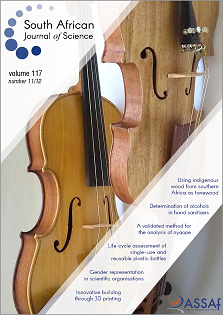Temperature and relative humidity trends in the northernmost region of South Africa, 1950–2016
DOI:
https://doi.org/10.17159/sajs.2021/7852Keywords:
agriculture, climate change, temperature, humidity, northernmost South AfricaAbstract
The northernmost Limpopo Province is located in one of the warmest regions of South Africa, where the agricultural sector is prone to heat stress. The aim of this study was to explore air temperature and relative humidity trends for the region, which have implications for agricultural adaptation and management (amongst other sectors). In particular, we investigated seasonal, annual and decadal scale air temperature and relative humidity changes for the period 1950–2016. Positive temperature trends were recorded for this period, averaging +0.02 °C/year, with the strongest changes observed in mean maximum summer temperatures (+0.03 °C/year). Interannual temperature variability also increased over time, especially for the period 2010–2016, which presents probability densities of <50% for minimum temperatures. Positive relative humidity trends (+0.06%/year) were also recorded for the period 1980–2016, but proved to be the least predictable weather parameter, with probability densities of <0.5% across seasons for the study period. Considering the substantial interannual variability in temperature and relative humidity, there is clear increased risk for the agricultural sector, particularly for small-scale farmers who generally have limited capacity to adapt. Climate science focusing on the southern African region should continue to establish the impact of climate change and variability on specific small-scale farming systems and enterprises, with recommendations for strategic adaptation based on up-to-date evidence.
Significance:
- Heat indices have increased, and variability in temperature and relative humidity has substantially increased over recent decades.
- Changes in air temperature and relative humidity have direct and/or indirect negative effects on sectors such as agriculture, leading to reduced productivity.
- The small-scale farming sector, which contributes significantly to national food security in developing countries, is the production system most exposed and vulnerable to observed changes/extremes in temperature and relative humidity.
- There is an urgent need to build capacity of small-scale farmers for appropriate adaptation to observed changes in climate based on up-to-date evidence.
Downloads
Published
Issue
Section
License

All articles are published under a Creative Commons Attribution 4.0 International Licence
Copyright is retained by the authors. Readers are welcome to reproduce, share and adapt the content without permission provided the source is attributed.
Disclaimer: The publisher and editors accept no responsibility for statements made by the authors
How to Cite
- Abstract 1142
- PDF 1155
- EPUB 240
- XML 254
- Supplementary material 135













.png)